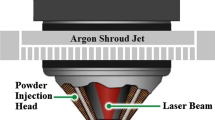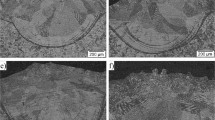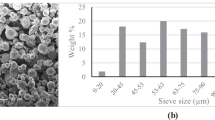Abstract
This paper studies the different lap joint methods of YCF101 alloy powder by direct laser fabrication (DLF) technology and analyzes the structure, porosity, cracks, and surface topography of multichannel forming parts fabricated by DLF to optimize the ideal lap joint mode. The selection basis of lap joint modes is based on the surface adhesion powder of single-layer cladding surface, inner cracks and porosity, and microstructure of the forming parts under different scanning modes. Regardless of any scanning method, there would be obvious sticky powder at the lap joint, and the pore and cracks are mainly present at the lap joint. The uneven energy density of the weld during the fusion process makes a great difference in the microstructure of the molten pool and the lap joint, the structure of molten pool is small isometric crystal, and the structure of lap joint is bulky dendrite. The defects caused by the uneven energy distribution and sticky powder had been improved by different lap joint modes between layers. The uniform distribution of the linear trace poles at the outer contour surface improved the surface quality of the forming part. As the mesh size of the cladding region that is divided by the cladding trajectory becomes smaller, the quality of forming parts has changed. The double decussation and outline mode has the smallest mesh size, the porosity is 0.47%, the microstructure of the lap joint area is no longer just dendrites, there appears isometric crystal and structure refining, the crack reduces, and the compressive strength is improved. To some extent, the problem brought by sticking powder and uneven heat distribution had been worked out.
Similar content being viewed by others
References
Farayibi PK, Abioye TE, Clare AT (2016) A parametric study on laser cladding of Ti-6Al-4V wire and WC/W2C powder. Int J Adv Manuf Technol 87(9–12):3349–3358. https://doi.org/10.1007/s00170-016-8743-9
Heigel JC, Michaleris P, Palmer TA (2015) In situ monitoring and characterization of distortion during laser cladding of Inconel® 625. J Mater Process Technol 220:135–145. https://doi.org/10.1016/j.jmatprotec.2014.12.029
Li P, Yang T, Li S, Liu D, Hu Q, Xiong W, Zeng X (2005) Direct laser fabrication of nickel alloy samples. Int J Mach Tools Manuf 45(11):1288–1294. https://doi.org/10.1016/j.ijmachtools.2005.01.014
He B, Li D, Zhang A, Ge J, Yang X, Hu X (2013) Influence of scanning pattern on the edge collapse of solid parts in laser metal direct forming. Opt Laser Technol 48:171–177. https://doi.org/10.1016/j.optlastec.2012.10.006
Farayibi PK, Abioye TE, Murray JW, Kinnell PK, Clare AT (2015) Surface improvement of laser clad Ti–6Al–4V using plain waterjet and pulsed electron beam irradiation. J Mater Process Technol 218:1–11. https://doi.org/10.1016/j.jmatprotec.2014.11.035
Zhou C, Zhao S, Wang Y, Liu F, Gao W, Lin X (2015) Mitigation of pores generation at overlapping zone during laser cladding. J Mater Process Technol 216:369–374. https://doi.org/10.1016/j.jmatprotec.2014.09.025
Tabernero I, Lamikiz A, Martínez S, Ukar E, Figueras J (2011) Evaluation of the mechanical properties of Inconel 718 components built by laser cladding. Int J Mach Tools Manuf 51(6):465–470. https://doi.org/10.1016/j.ijmachtools.2011.02.003
Bi G, Sun CN, Gasser A (2013) Study on influential factors for process monitoring and control in laser aided additive manufacturing. J Mater Process Technol 213(3):463–468. https://doi.org/10.1016/j.jmatprotec.2012.10.006
Ren L, Sparks T, Ruan J, Liou F (2008) Process planning strategies for solid freeform fabrication of metal parts. J Manuf Syst 27(4):158–165. https://doi.org/10.1016/j.jmsy.2009.02.002
Liu J, Li L (2005) Study on cross-section clad profile in coaxial single-pass cladding with a low-power laser. Opt Laser Technol 37(6):478–482. https://doi.org/10.1016/j.optlastec.2004.07.010
de Oliveira U, Ocelík V, De Hosson JTM (2005) Analysis of coaxial laser cladding processing conditions. Surf Coat Technol 197(2–3):127–136. https://doi.org/10.1016/j.surfcoat.2004.06.029
Sun J, Liu X, Tong Y, Deng D (2014) A comparative study on welding temperature fields, residual stress distributions and deformations induced by laser beam welding and CO2 gas arc welding. Mater Des 63:519–530. https://doi.org/10.1016/j.matdes.2014.06.057
Wang Y, Zhao S, Gao W, Zhou C, Liu F, Lin X (2014) Microstructure and properties of laser cladding FeCrBSi composite powder coatings with higher Cr content. J Mater Process Technol 214(4):899–905. https://doi.org/10.1016/j.jmatprotec.2013.12.009
Mvola B, Kah P (2016) Effects of shielding gas control: welded joint properties in GMAW process optimization. Int J Adv Manuf Technol 88(9–12):2369–2387. https://doi.org/10.1007/s00170-016-8936-2
Zhang K, Liu W, Shang X (2007) Research on the processing experiments of laser metal deposition shaping. Opt Laser Technol 39(3):549–557. https://doi.org/10.1016/j.optlastec.2005.10.009
Mondal S, Bandyopadhyay A, Pal PK (2013) Application of artificial neural network for the prediction of laser cladding process characteristics at Taguchi-based optimized condition. Int J Adv Manuf Technol 70(9–12):2151–2158. https://doi.org/10.1007/s00170-013-5393-z
Liu S, Kovacevic R (2014) Statistical analysis and optimization of processing parameters in high-power direct diode laser cladding. Int J Adv Manuf Technol 74(5–8):867–878. https://doi.org/10.1007/s00170-014-6041-y
Marzban J, Ghaseminejad P, Ahmadzadeh MH, Teimouri R (2014) Experimental investigation and statistical optimization of laser surface cladding parameters. Int J Adv Manuf Technol 76(5–8):1163–1172. https://doi.org/10.1007/s00170-014-6338-x
Calleja A, Tabernero I, Fernández A, Celaya A, Lamikiz A, López de Lacalle LN (2014) Improvement of strategies and parameters for multi-axis laser cladding operations. Opt Lasers Eng 56:113–120. https://doi.org/10.1016/j.optlaseng.2013.12.017
Pi G, Zhang A, Zhu G, Li D, Lu B (2011) Research on the forming process of three-dimensional metal parts fabricated by laser direct metal forming. Int J Adv Manuf Technol 57(9–12):841–847. https://doi.org/10.1007/s00170-011-3404-5
Amine T, Newkirk JW, Liou F (2014) An investigation of the effect of laser deposition parameters on characteristics of multilayered 316L deposits. Int J Adv Manuf Technol 73(9–12):1739–1749. https://doi.org/10.1007/s00170-014-5951-z
Gan Z, Yu G, He X, Li S (2017) Numerical simulation of thermal behavior and multicomponent mass transfer in direct laser deposition of Co-base alloy on steel. Int J Heat Mass Transf 104:28–38. https://doi.org/10.1016/j.ijheatmasstransfer.2016.08.049
Bedenko DV, Kovalev OB, Smurov I, Zaitsev AV (2016) Numerical simulation of transport phenomena, formation the bead and thermal behavior in application to industrial DMD technology. Int J Heat Mass Transf 95:902–912. https://doi.org/10.1016/j.ijheatmasstransfer.2015.12.046
Zhao H, Zhang G, Yin Z, Wu L (2011) A 3D dynamic analysis of thermal behavior during single-pass multi-layer weld-based rapid prototyping. J Mater Process Technol 211(3):488–495. https://doi.org/10.1016/j.jmatprotec.2010.11.002
Verma A, Tyagi S, Yang K (2015) Modeling and optimization of direct metal laser sintering process. Int J Adv Manuf Technol 77:847–860. https://doi.org/10.1007/s00170-014-6443-x
Manurung YHP, Sulaiman MS, Abas SK, Tham G, Haruman E (2014) Investigation on welding distortion of combined butt and T-joints with 9-mm thickness using FEM and experiment. Int J Adv Manuf Technol 77(5–8):775–782. https://doi.org/10.1007/s00170-014-6268-7
Ocelík V, Eekma M, Hemmati I, De Hosson JTM (2012) Elimination of start/stop defects in laser cladding. Surf Coat Technol 206(8–9):2403–2409. https://doi.org/10.1016/j.surfcoat.2011.10.040
Li G, Zhang M, Huang J, Sun Z, Wu Y (2015) A comparative study on microstructure and properties of Inconel 52M overlays deposited by laser beam and GTA cladding. Int J Adv Manuf Technol 81(1–4):103–112. https://doi.org/10.1007/s00170-015-7198-8
Funding
The authors gratefully acknowledge the support from the Ministry of Industry and Information Technology of China (No. 201675514). The authors also acknowledge the support from the Key Laboratory of Shenyang (No. 15153100).
Author information
Authors and Affiliations
Corresponding author
Rights and permissions
About this article
Cite this article
Zhao, Y., Yu, T., Sun, J. et al. Effect of laser cladding on forming qualities of YCF101 alloy powder in the different lap joint modes. Int J Adv Manuf Technol 96, 1991–2001 (2018). https://doi.org/10.1007/s00170-018-1732-4
Received:
Accepted:
Published:
Issue Date:
DOI: https://doi.org/10.1007/s00170-018-1732-4




